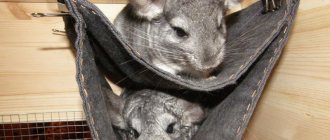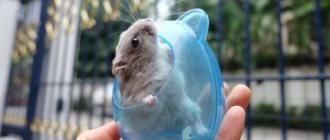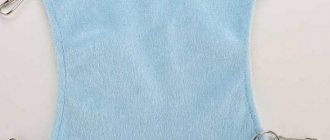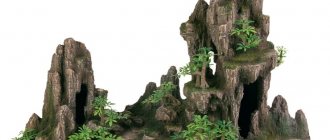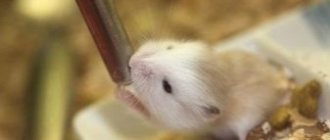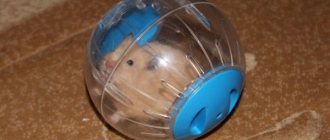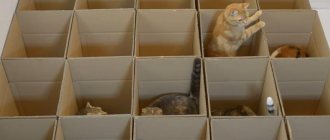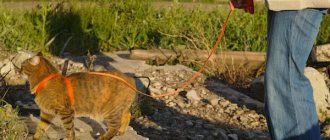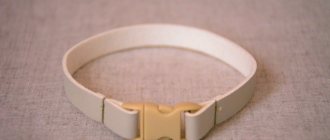A mandatory, and perhaps even the most important accessory to your pet’s cage is a house. This is his sanctuary for napping during the day, as well as an object for him to “chew” at night.
If the animal lives with you alone, then a “bedroom” 30 cm wide and 20 cm high and deep is enough for it. For two or more chinchillas, it is worth providing two options: they also have showdowns, and each shows its own character!
The design of a chinchilla house can be very different. But what is necessary for all products is the presence of an entrance, windows, and, naturally, the apartment should not be cramped - a chinchilla needs free space almost like air.
Buy or make it yourself?
You need to get a home for your chinchilla much earlier than you plan to buy a pet. In such cases, the question of purchasing often arises; fortunately, pet stores have a selection of cages and display cases for every taste.
But they are not always suitable for the future owners of furry cats. So, a shelter house in a cage may be too small, and the pet will be uncomfortable in it; or the boards are carelessly sanded, and therefore chinchillas constantly cling to hangnails with their wonderful fur, literally tearing them out; or the parts are glued together with such a quantity of glue that the animal, gnawing wood due to its “gnawing” nature, can swallow this glue with all the ensuing consequences for its gastrointestinal tract.
Based on all this , an owner with skillful hands can independently make a house for a chinchilla with his own hands, which will be no worse, and in some cases better, than a purchased one. In addition, it will not only be safe - chew as much as you want! - but also cozy.
What size should a chinchilla cage be?
Housing requirements
For normal maintenance, a suitable option is selected. There are several requirements for the house:
- Right size. Each pet will need a room 30 by 20 by 20 cm or larger. When there are several animals, the size is multiplied by their number.
- It is desirable that the roof be without slopes. Chinchillas climb there. A flat roof is safer. Plus it becomes another vacation spot.
- Safety is important in other parts too. The home is inspected for sharp corners, burrs and the like. Chinchillas move actively and chew objects. Reliability of fastenings is important. It happens that restless pets overturn houses.
- Chinchillas love to climb and jump. The dwelling is often placed on a hill, for example, on a shelf in a cage. It should be low to avoid injury.
- After installing the home, there should be room for toys, a hammock, a tray and other items.
Shusha, go out to the balcony!
The size of the house must be increased if the project includes a balcony.
In such a shelter, the area of the side and rear walls is the same. The entrance to it must be at least 14 cm in height. The distance from the entrance to the wall on the right depends on the type of fastening.
If dowels are used, a 3-centimeter distance to the right wall will provide greater strength; if fastening is carried out using self-tapping screws, the distance can be made smaller.
For the balcony, cut a board 35 cm long and 22 cm wide.
These dimensions can be increased at your discretion, but you should not reduce them.
The end of the board that will be on the outside is cut at a certain angle.
The entrance from the balcony inside should be 11 centimeters wide, no less. If you maintain all the specified parameters, then the balcony ledge will be 14 and a half centimeters, that is, a chinchilla can not only crawl on it, but it will also withstand her jumping.
Do you want to make your balcony more spacious? Then remember that the extra 5 cm in length will require attaching additional support to the edge so that the board does not break off under the weight of the animal.
Many experts claim that chinchilla houses with a balcony have a number of advantages:
- greater safety,
- wider possibilities for the pet’s “daily routine”,
- twilight reigning in the house.
The little animals themselves feel safer thanks to the presence of two entrances to the shelter - the main one and the balcony; this seems to, from the chinchilla’s point of view, provide an additional escape route in case of danger.
The “decoding” of the second point includes both hours of rest and a variety of hours of play for the pet. The balcony is an extra “entertainment” shelf for him.
And the twilight provides comfort during the daytime rest.
Static toys
These entertainments can also be classified as interior entertainment, since they look less like toys and more like pieces of furniture in your pet’s home. However, they allow the animal to maintain activity at the proper level.
Shelves are a universal exercise machine for rodents that have weak front legs and strong hind legs. They allow the animal to jump, quickly changing its location. The optimal height for the shelf is 80 centimeters. The animal will easily jump to it and, if it falls, will not be hurt. In addition, with the help of a shelf, the rodent sharpens its teeth well.
Shelves in a cage
You can prepare the shelf yourself:
- choose a small wooden board of any size (for example, 40x20 centimeters);
- rinse the workpiece thoroughly and pour boiling water over it to get rid of possible parasites;
- leave the product until completely dry;
- sand the board so that there are no nicks, sharp corners, or roughness left;
- set it at the desired level.
Place ledges throughout the cage at different levels so that the animal jumps back and forth.
Cascade of shelves
Tunnels
Fluffies love to hide in pipes of different diameters, making their way through them and running after each other. The tunnels can be of any size, but at least 30-40 centimeters in diameter, so that the pet does not get stuck inside.
Animal in the tunnel
Tunnels are mainly made of plastic and wood, and the second option must have an iron edging so that the chinchilla cannot chew the edges. Some manufacturers offer a whole network of tunnel passages made of plastic, which can be disassembled and assembled, giving the shape as desired.
Tunnel system
Translucent plastic is recommended as a material: the animal will feel safe there. You can always find a rodent who has simply fallen asleep inside the exercise machine, without fear that he is stuck there.
Sticks and ladders
An ordinary wooden stick placed in a cage causes no less delight in the tailed ones; it can be rolled, chewed, and climbed up (if you place it between the floor and the shelf). The ladder is a modernized version of the stick that performs similar functions.
Ladder in the house
Sometimes rodents use it as a device to scratch their backs on - just place it vertically near the wall of the cage.
We invite you to familiarize yourself with: Tit ⭐ Photo, description, habitat, food, enemies ✔
Hammocks
By installing this device inside the cage, you will see how much your chinchilla will love it. In this mini-bed you can not only relax, but also sway from side to side, like on a swing.
Chinchillas in a hammock
Most commonly used materials:
- tree;
- thick fabric;
- bendable but durable plastic.
In addition, hammocks can be single-tiered or double-tiered (in the form of a tube). The second option gives more options. In case of danger and when it is cold, the animal hides inside. In the summer, the pet cools off upstairs.
Sewing a hammock at home
Among the many types of hammocks to create with your own hands, it is better to choose a classic one, especially if you do not have enough practice in needlework. You will need:
- 2 pieces of thick denim or fleece fabric 45x45 centimeters;
- skein of thread;
- edge tape;
- needles;
- scissors.
Some tips
Construction of a shelter for a chinchilla requires the use of only clean and durable quality materials. It can be board or plywood.
Not every type of wood is suitable for this purpose. It is worth knowing that birch or ash are softer than beech and pine, which means they will succumb to the teeth of a rodent more quickly. It is better not to use oak boards at all because of the tannins they contain: your pet can chew them and develop severe diarrhea.
The house should be made according to an individual drawing indicating the exact dimensions.
Often, animals themselves arrange their own personal corner, providing it with a sufficient amount of hay/straw. Therefore, you should not cover the floor with any other filler.
To clean the house, you can use several options, for example, do:
- removable bottom
- removable one of the walls,
- opening roof.
Step-by-step master class on making a cage
First, you need to fasten the profiles using self-tapping screws and connecting fittings, then you should insert the walls into special holes, securing them with seals. The bottom of the future cage will be plywood or laminate with glass on top (to protect against leaks and scratches).
We assemble the lid for the cage with our own hands using profiles and mesh; we fix the glass doors in front, which will subsequently be closed with a lock. It is also better to make the side walls from mesh for clearance and passage of fresh air. Next, we attach shelves to the side walls with a distance of at least 20 cm from one to another.
In order to build a cage for a chinchilla with your own hands, you need to prepare:
- Aluminum profiles (their length is calculated individually).
- Walls made of fiberboard and self-adhesive.
- Rubber seals.
- Mesh (mesh 25x12 mm, thickness not less than 0.9 mm).
- Wheels.
- Self-tapping screws.
- Connectors for profiles.
- Lock.
- Glass for the front wall and bottom.
- Plywood or laminate for the bottom.
The house for the chinchilla itself is made with your own hands from wood plywood. The shape of the structure may be different. The main thing is that it has an entrance, windows and enough free space, because Shushiki need this like they need food or air. It is better to fasten plywood to each other using furniture round dowels with a diameter of 6 mm.
Drawing up a drawing
Before you get to work, it is very important to draw up a competent drawing with accurate measurements of the parts. Calculate how many lengths of aluminum profiles you need, how much mesh will go on the side walls and the size of the removable cover. Measure the bottom, calculate the approximate number of shelves, then accurately measure the distance on the walls.
To assemble a house for a chinchilla, you will need to take boards at least 15 mm thick. The length, height and depth of the house depends on the number of rodents in the cage. If you have one or two shushiks, you can take two boards measuring 32x17 cm, two more 23x17 cm and one 34x26 cm. Before fastening them together, draw future holes with a pencil and cut them out with a jigsaw.
Using a drill, make holes with a diameter of 5 mm on the walls and roof. Insert dowels into them with one edge and hammer the other into the other hole. The house for chinchillas with your own hands is ready!
Original ideas
Creative owners of furry pets offer interesting options for making multifunctional houses. So, one of them is a house combined with a hay barn: shelter - one, material for gnawing - two, a place for hay placed between the sticks - three. To make such a product you need a minimum of materials:
- board as a roof,
- dry birch or hazel sticks (due to the density of this type of wood, the chinchilla will chew them longer),
- a block for fastening them,
- small screws, screws or nails - for the same purpose.
When finished, the house looks like a nice and quite cozy hut for a rodent.
You can make a special “gnawing” fastening them with the same connecting parts.
Below are the drawings of the houses - several options.
Homemade houses are also an economical option. If you build an entire cage or display case for a chinchilla with your own hands, its total price will be several times lower than the store price. So, dear craftsmen, get a jigsaw in your hands!
Why does a chinchilla need a house?
It must be said right away that it doesn’t matter to your pet how his home will look externally; this should rather bother you. The most important thing for a pet is that the house is comfortable for him. The main purpose of this object in an animal cage is the possibility of privacy. There the pet should be able to rest peacefully. You need to install the house in a far secluded corner of the cage, where no one will disturb your pet’s sleep.
Types of houses
Nowadays you can see a huge variety of house models in pet stores; they are made from the following materials:
- Tree.
- Ceramics.
- Plastic.
- Straw.
- Twine.
The pet will quickly destroy structures made of straw or twine. The shape can be made into round, triangular, oval and rectangular designs. A variety of models can be seen in the photo.
Advice. Models in the form of wooden huts, also medieval majestic castles, and Indian wigwams will look cool.
When choosing what the future design will be, you need to adhere to some recommendations:
- Choose the design size depending on the size of your pet.
- There should be no holes in the structure in which the animal could get its paw stuck.
- Provide an entrance and a window for ventilation.
- Designs without a bottom are easy to care for.
- A flat roof will be the safest; your pet will not be able to fall from it.
- Please note that the design does not contain dangerous, sharp elements that could injure the animal.
Advice. The corner design will be very compact; it does not take up much space.
If you are the owner of two pets, then you will need to install a spacious house or there should be two of them at once.
Advice. If your chinchilla's cage is small and there is no room for a house, consider mounting it externally.
Breeding chinchillas as pets
It will no longer be possible to breed chinchillas for fur in a simple city apartment, because a whole family of rodents will not fit in one cage. They will need a specially equipped enclosure. On farms for these animals, enclosures are installed that do not block access for males to females, because if they do not meet, offspring will not appear.
These cute creatures will live comfortably in places with temperatures of about 20 degrees. The animals are very sensitive to heat and less sensitive to cold. Make sure that the air temperature does not drop below zero!
Chinchillas will not live on metal bars, so place hay or sawdust on the bottom of the cage.
We suggest you familiarize yourself with: Nest house and perches
As mentioned above, you can have chinchillas in an apartment or in a house. But it is worth remembering that it will not be possible to have more than two individuals. You will definitely need to purchase a cage for your unusual pets that will be comfortable and of a suitable size. 14-20 degrees Celsius will be the most suitable temperature for this type of rodent to live. Remember the most important thing: they absolutely cannot tolerate drafts or sunlight that falls directly on them.
Chinchillas that are bred at home very quickly get used to people and become completely tame. They will not be afraid of people. They will be very sweet, kind and friendly. But forget about the fact that they can be let out for a walk around the apartment. Rodents are natural chewers, so keep them in a cage. The size of the chinchilla cage must be chosen correctly to ensure the pet’s comfort.
If you don’t want to buy a cage for your chinchilla, you can make it yourself! All that remains is to find out the dimensions of the structure and build it with your own hands. It won’t be difficult to make a cage, the main thing is to want and try. As an example, you can use the photos given in the article.
Advantages and disadvantages of chinchilla cages
Once again about the advantages of a do-it-yourself cage. Of course, in our era of progress, finding a ready-made cage for chinchillas is not difficult. But capitalism is capitalism, and this purchase will definitely cost you a pretty penny. If we talk about a decent cage. There is an option and buy a cheap one, but made in China. Well, we can’t even talk about the quality of products from China, since there is no quality at all.
Accordingly, any specialist will recommend that you make a cage with your own hands. And here it’s up to your imagination and finances. You yourself will select high-quality and reliable materials, calculate the required size and shape of the “house” for the chinchilla. And create the necessary level of comfort and reliability for the animal.
Prevention and care of the house
To protect your pet, the installation of the house is carried out with an eye to prevention:
- the dwelling must be tightly attached to the wall or mesh;
- Careful adjustment of the surfaces is important (no gaps where a curious animal would immediately stick its paw);
- various chips and cracks are excluded;
- It is extremely undesirable to use traumatic fasteners - iron screws or self-tapping screws.
Home maintenance is quite simple.
